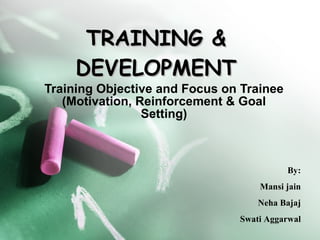
TRAINING OBJECTIVES KEY TO EFFECTIVE LEARNING
- 1. TRAINING & DEVELOPMENT Training Objective and Focus on Trainee (Motivation, Reinforcement & Goal Setting) By: Mansi jain Neha Bajaj Swati Aggarwal
- 6. Writing Training Objectives Identify the Objectives from TNA CLARIFY & Select the actionable Objective Establish Priorities Put into a Logical Flow Check for feasibility
- 12. KSAs No trait & treatment interaction A trait & treatment interaction Individual Trait Individual Trait Learning Objectives Learning Objectives Low Low Low Low High High High High Training design A Training design A Training design B Training design B
- 13. Motivation of Trainee Motivation is simply - The reason for an action - That which gives purpose and direction to behaviour.
- 15. HERZBERG'S MOTIVATION HYGIENE THEORY
- 19. Example Outcome if successful E2 V Outcome if Unsuccessful E2 V Promotion 0.2 7 Does not have to change behaviour 1.0 10 Better at job 0.6 8 Employees still afraid of him 1.0 8 Less tension between bill & Others 0.7 6 Not ridiculed by coworkers for being a nice guy 1.0 9 Less feeling of stress 0.8 4 Better relationship with union 0.4 7 Fewer grievances 0.6 9
- 23. Reinforcement methods & tools • A process for Managers/Supervisors to follow in preparing their staff members for training and in following up once the training is completed • Podcasts done in "talk radio" style clips to reinforce skills taught in the classroom. • Pocket-sized skill checklists for use by Managers as they observe their people on the job • Training for Managers on how to coach and give tailored feedback to their staff members • Laminated wallet-sized skill reminder cards for participants • Skill reinforcement on CD or DVD • One-on-one observation and coaching of participants by Global Learning Link • Online knowledge quizzes coupled with incentive programs
- 28. Thank You
Editor's Notes
- Ten Steps for Goal Setting and Planning 1. Establish goals. Decide what competencies to focus on in supervision. 2. Include your supervisee in selecting goals and in planning. 3. Customise your plan. Consider the developmental level of the supervisee, their needs and desires, as well as the needs of the system and population served. 4. Write out goals. 5. Make goals as specific, clear, objective, realistic, and obtainable as possible. 6. Create a hierarchy of objectives. Recognize that some goals and competencies need to be addressed first while others can be addressed later in time. 7. Divide goals into competency areas: • Knowledge and theory • Practice and skill • Personal self-awareness 8. Select methods and techniques to best accomplish goals. Expand repertory. 9. Tie goals to evaluation. Come up with one or two indicators of successful completion in each goal area. 10. Revisit and review goals periodically. Update and make changes as necessary.
- A) At the beginning of placement Setting new and general goals for learning, according to the special characteristics of the placement setting , and the developmental level of the trainee . B) During mid-term evaluation Setting specific remedial goals if the trainee is lacking certain competencies to fulfill the placement requirements